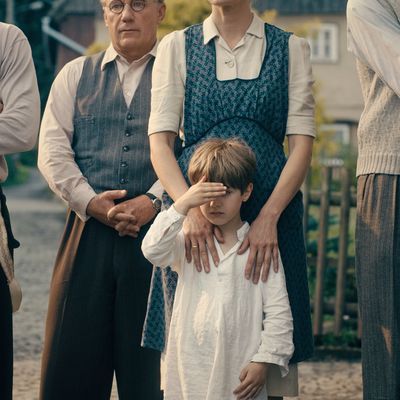
It’s objectively unfair to be harder on a clunky film that has been nominated for an Oscar than on one that few people will see, but objectivity is overvalued and I’m going to give Florian Henckel von Donnersmarck’s Best Foreign Language Film nominee Never Look Away the Middlebrow Beanbag Award of 2019. The three-plus hour movie has all the ingredients that a filmmaker needs to grab the bourgey-est segment of the arthouse (or Academy) audience: Nazis (or their Soviet and East German successors); tony cinematography; fresh-faced young actors and actresses who are frequently naked, the light sculpting their perfect derrieres; lofty babble about truth and beauty; and a distinctive mix of indignation (at government suppression of artistic freedom) and philistinism (toward the avant-garde). The movie is a laugh riot if you’re in the right, derisive mood, but first — fair warning — you need to get past a scene in which women deemed by the Nazis to be inferior specimens are led into a shower and gassed, the camera coming to rest on a beautiful young martyr’s baby-blue eyes gazing heavenward.
Von Donnersmarck (who already has an Oscar for the much better The Lives of Others) makes clear that there is a heaven, although not the one you’ll hear about in church. It’s the sudden awareness of the oneness of all things, brought on by making or merely observing (I mean hard observation) works of art. The hero, Kurt Barnert, experiences that oneness from an early age under circumstances both exhilarating and tragic. We meet him as a boy being led by his beauteous-free-spirt aunt Elisabeth (Saskia Rosendahl) into the Third Reich’s infamous Degenerate Art exhibit — a collection of works deemed criminal for not “elevating the soul” according to National Socialist ideals. Elisabeth has a different response. “Don’t tell anyone, but I like it,” she whispers naughtily into her nephew’s ear — “it” being a Kandinsky that would now go for $8 billion. (She has good taste.) She loves these works for their messy impudence, their boundary-flouting. She’s so enraptured that she later asks a group of bus drivers to shine their headlights on her and honk their horns simultaneously while she holds up her arms and experiences transcendent oneness. I didn’t understand that either but it provides an occasion for the Oscar-nominated cinematographer Caleb Deschanel to move the camera in an arc and the composer Max Richter to do his familiar sawing-string shtick with less than his usual melodic invention.
Alas, Elisabeth will soon run afoul of Professor Carl Seeband (Sebastian Koch) an ob-gyn and fervent Nazi eugenicist who has no scruples about sterilizing or shipping off to be euthanized anyone posing a threat to the Aryan gene pool. There have been a lot of bad hombres onscreen in the last few years but Herr Seeband (“Professor Seeband,” he would correct me) is in a class of his own. He’s not a scenery-chewer or a pensive psycho-philosopher like Thanos in Infinity War. Koch plays him as blandly cunning, an empty suit — but one that is desperately refilled with the prevailing ideology, be it Nazism, GDR Communism, or Western Capitalism. The swine does believe in eugenics, though. Even where his family’s concerned, he’ll put his forceps where his mouth is.
Forty-five minutes into Never Look Away, we meet the grown Kurt (Tom Schilling), now living under Soviet rule in Dresden and forced to apply his talent in the service of Socialist Realism. The “degenerate” artists are still the bogeymen (“Obscene formalism … ‘Me me me’ leads to misery… Art should be in interest of the working man …”), but now the paragons are men and women holding hammers aloft, eyes shining in anticipation of a glorious future. The weird thing about Never Look Away is that as much as Kurt chafes against Soviet aesthetics, damned if he doesn’t look and act like one of those paragons himself. He and he woman he instantly falls for, Ellie (Paula Beer), are so absurdly good-looking that they could be one of those poster couples, “building a Glorious Future, Comrades!” The actors are good, but their lovemaking has no raw edges, no messiness. Deschanel lights them like sculptures — art objects — while Richter saws away to serenade their transcendent oneness. It’s Middlebrow Realism, comrades. (I did like the pink angora sweater Ellie wears in one scene — it would have made Ed Wood scream with pleasure.)
Kurt and Ellie turn out to be connected in a more literal way (I won’t spoil it), one that helps Kurt — after many false starts — home in on his artistic soul. There are innumerable howlers in the movie’s third hour, after Kurt and Ellie escape to the West and Kurt joins a Dusseldorf Academy run by a tortured artist (Oliver Masucci) with a lulu of a backstory to explain why he never takes off his hat and only uses felt and emollients in his art. I’m trying to decide which shot is the most unintentionally hilarious. It might be the one in which Kurt and Ellie get to the West and emerge — as part of a montage — from a theater showing Psycho, and I flashed on Leslie Nielsen and Priscilla Presley in The Naked Gun staggering in hysterics out of Platoon. But it’s probably the big reveal, when artistic truth comes to Kurt after weeks staring at a blank canvas via the wind — stirring leaves, a breeze from on high, mystical superimpositions. We’re a long way from Degenerate Art, sadly.
Never Look Away was inspired by the life of the onetime photo-realist painter Gerhard Richter, who was understandably appalled by what he saw. I wonder if when Richter watched his fictional alter-ego devise the signature technique of “blurring” the photo-realist image, he wanted to reach out his hand and smudge the actor’s face into the canvas.
It won’t win the Oscar, by the way. Too long.


